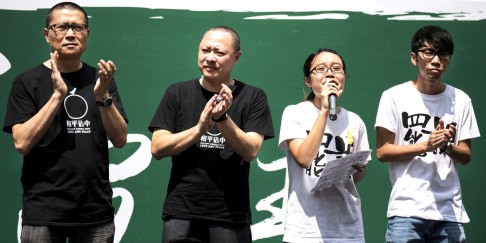How Occupy Central leaders lost grip on protest
They lacked means to direct demonstrators, who were isolated by police

After police used tear gas, Occupy leaders called on protesters to retreat to Tamar Park, but some remained on the road.
Co-founder Chan Kin-man said the crowds that stormed onto Harcourt Road and Connaught Road Central were "not under [Occupy's] control". "Their actions were not organised by us," Chan said.
The crowds on those roads were peaceful, he noted, and "it was the police who provoked them with tear gas".
Another co-founder, the Reverend Chu Yiu-ming, conceded that bringing forward the Occupy date had affected the movement's operation.
"A lot of our equipment was unable to be used, including the audio and portable toilets," Chu said. Their walkie-talkies had also not arrived. Police confiscated the audio equipment, including amplifiers, saying they were not allowed at an unlawful assembly.
The lack of communication tools considerably weakened the command of Occupy leaders.
Watch: Co-organiser Benny Tai declares start of Occupy's civil disobedience action
The original venue of Occupy was believed to be Chater Road in the heart of Central and near MTR stations. Tim Mei Avenue, isolated by busy roads from inner Admiralty and connected to the MTR only through footbridges, proved to be an unfavourable spot for a mass protest and was easy for the police to blockade.
Significant police reinforcements overnight and their closure of access points from Admiralty meant that protesters who turned up in the afternoon could not reach the core protest area.
Thousands of them, blocked by police, gathered near Fenwick Pier Street and Performing Arts Avenue, unable to see or hear the Occupy leaders. Democrat Lee Wing-tat tried to control the scene in this area, but without a speaker he could only shout and tell people to sit on the road.
The lack of command and the invisibility of Occupy leaders in the Fenwick Pier Street area proved crucial - dozens of youngsters soon became impatient and broke through police cordons, stormed Gloucester Road and tried to get to Tim Mei Avenue to join the Occupy crowd.
Not long after, another crowd at Admiralty Centre, where police stopped people from getting onto the footbridge to reach Tamar, also poured onto the road.
Ma Ngok, a political scientist at Chinese University, said Occupy leaders "should not be blamed" for bringing forward their campaign. "They were only riding on the developments of the class boycott," he said.
But he also noted that Occupy had originally planned to start with a letter-of-no-objection from police on October 1. "Now, without the letter, Occupy leaders put themselves in an unfavourable position, giving police an easy excuse to seal off the protest site and bar equipment".



